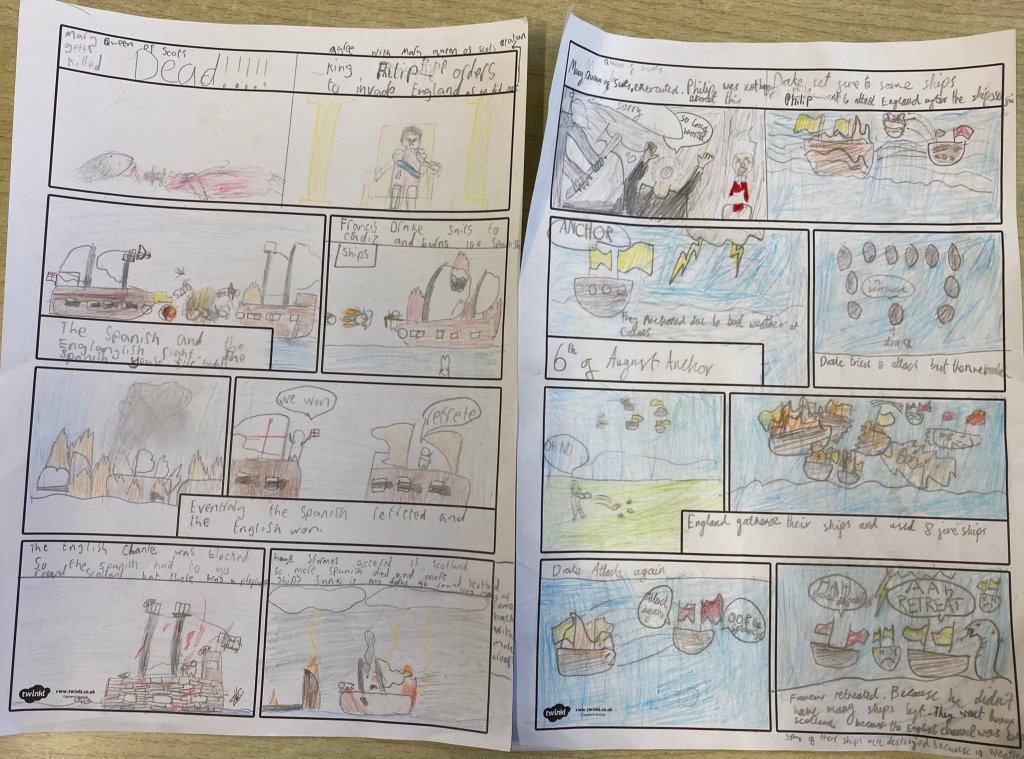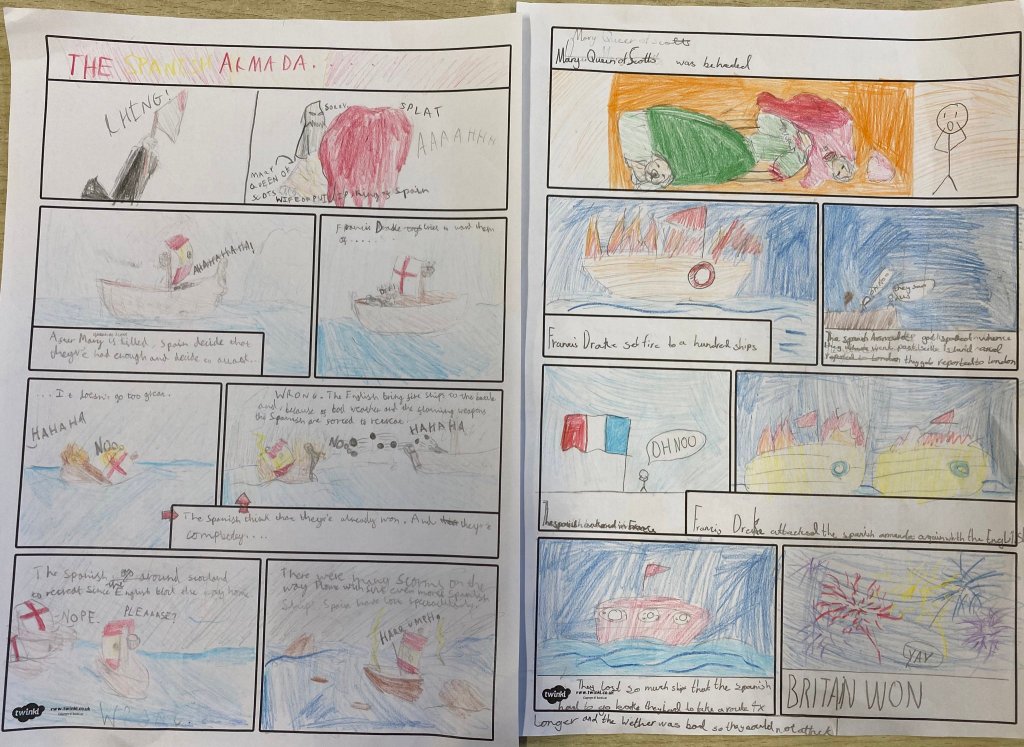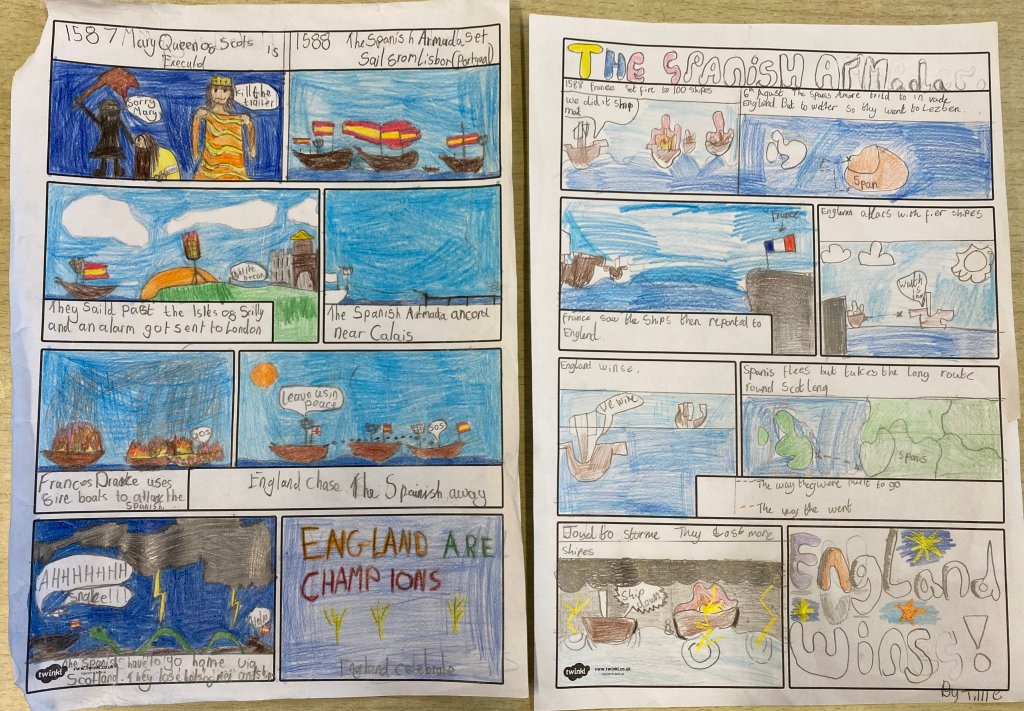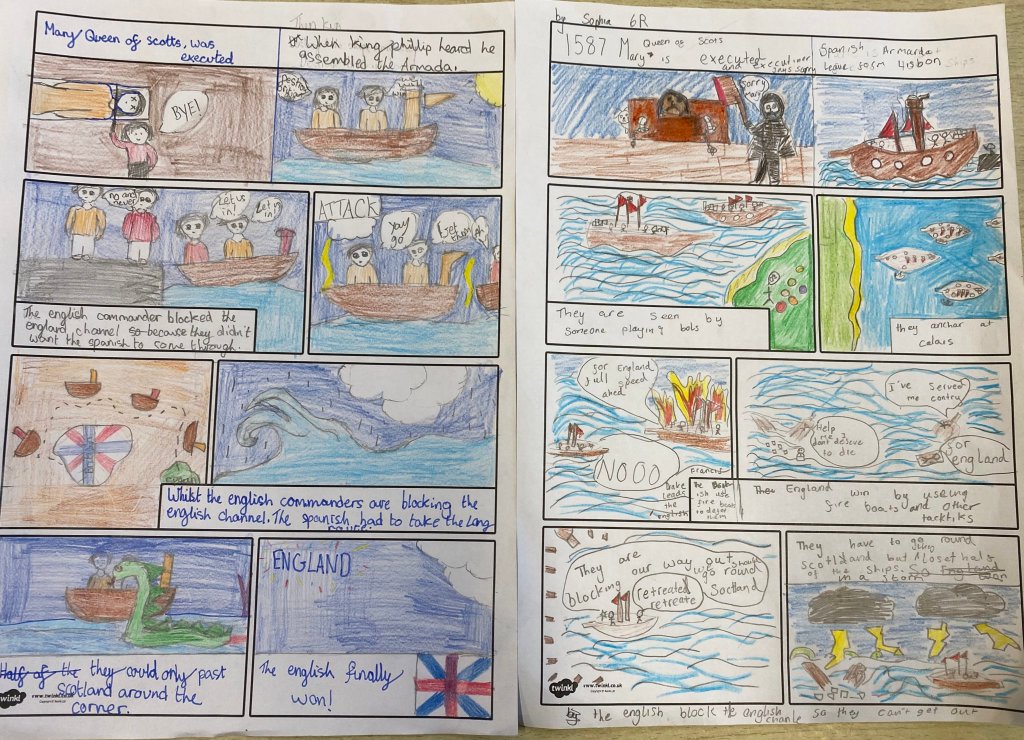Despite it nearly being the end of term, we have been working frantically through some of our curriculum lessons this week, in a bid to catch up and ensure that the class have been taught about more than just Henry VIII during our Tudor topic. After looking at the relationship between Elizabeth and Mary during our work on Tuesday, it was time to cover the Spanish Armada on Wednesday. I won’t lie, I knew that somebody else had already planned and resourced the lesson, so I had ignored it until about 9:05, when the class were in assembly. After looking through the lesson, I could see that the suggested tasks were perfectly fine but felt like we could push them a bit further, so as always, I resorted to my safety blanket of comics. Doing a storyboard had already been suggested but I thought that might limit us a touch and my class are very enthusiastic about creating their own art/comics. Also, this would also give me some time to catch up on some admin that needed addressing thanks to the joy of assessments last week. Comics it was then.
After going through a powerpoint about some of the key events of the Spanish Armada along with the political and religious implications that fuelled it, the class were set on their way. We have been talking a lot as a school about making sure our work has a clear audience and purpose, this is to try and ensure that writing is effective and that standards increase. We weren’t making the most of writing opportunities at times and it was clear that sometimes the children just thought you did writing because you were told to. I explained that their comic needed to include enough detail to inform someone who knew absolutely nothing about the Spanish Armada. The idea being that if they walked into our classroom and picked up a comic, they would have a solid idea of what had happened and why. As an extra incentive, I promised that I would share some of the work online with other teachers and authors. This may seem a bit of an unfair bribe and expectant of people online, but their desire to make sure it was their best work really ramped up with the knowledge that they could potentially have a global audience. Apologies if you have been harassed by me because of this but it is for a good reason I promise.
Using the medium of comics allowed them to include some of the smaller details that may have been lost in another form. For example, when Mary Queen of Scots was executed, it is reported that the executioner apologised for having to do it. Lots of the class used speech bubbles to show that detail and you will find a lot of axe wielding characters saying “I’m sorry” in their work. Some even chose to draw a little dog hidden under Mary’s dress, had we been doing the task differently I’m not sure that this extra detail would have made it in. Another benefit of the comics was thanks to using the drawings and speech bubbles in this efficient way, the children were able to squeeze more detail and information into one page than anticipated. It also empowered those who found the artistic side more challenging to use speech to fill up drawing space, while those who loved drawing could use less speech and draw as many details in as possible. As many approached the end of the story and the Spanish were fleeing past Scotland, several Loch Ness monsters appeared to add some folklore to the piece and allow the creator to make their comic different and unique to the others. Of course, once I praised one person for a good idea, multiple versions soon appeared!
As an idea, there was nothing particularly inventive or radical about it. The main reason it worked was simply because I gave them a chance to tell a story through a comic rather than just write a generic paragraph or text about it. As I said earlier, the comic format presented them with good opportunities to add in little details and show their deeper understanding of the story, although in some cases they put more effort into this and got the events in a slightly different order! Next time you’re doing something in science, geography or history why not give them a chance to tell their story a different way and see what comes out.




Wow! This is phenomenal work. The attention to detail is incredible. I used to work with Mr Ruddick and he was teaching some amazing lessons with graphic novels even then. Well done to all of you, this is work of which you can all be genuinely proud. Please keep it up.
LikeLike
What a clever use of both illustration and text, Year 6. I loved that lots of you put the comic into comics with commentary running alongside historical writing. The ‘Yay’s for the winning side, and the ‘Sorry Mary’ show much more than you could convey in just text alone. Keep up the good work!
LikeLike
Despite being a school librarian for over thirty years, I only started reading graphic novels regularly ten years ago when challenged to do so by my godson and now I’m hooked! I can see how many of you are very familiar with narrative and information told in graphic format. I love the mix of facts alongside touches of humour. This brings the history alive for the audience and makes it so much more appealing. They reminded me of Corpse talk. The standard of work is excellent; you should be very proud of your efforts. Thank you for sharing.
LikeLike
Incredible work from all involved! A wondrous use of the comic format and with so many variations on the same story. They were a joy to read.
I especially like the humanity given by many to the executioner. Despite the executioner’s concealed face and gruesome job, it reminds the reader that they were people to. Whether it’s saying ‘bye’ to Mary Queen of Scots or a ‘sorry’ for what had to be done, all of the comics do well to engage readers from the first few panels.
I particularly liked the use of dramatic perspectives in the third comic. Tension is instantly created by framing just the falling axe and as the view moves behind Mary Queen of Scots’ now-absent-head in the second panel, the focus shifts to the executioner saying ‘sorry’ — as if to highlight the burden they will now carry for the rest of their life.
Excellent use of colour throughout the comics by the creators too! While it may not have necessarily been intentional, comic 6 uses the same dark blue in panel one and panel seven: both of which mark dramatic turning points in the narrative. It is a visual cue which subconsciously guides the reader.
Beautiful work from all involved and a big congratulations to your class from myself and the rest of the Dekko team.
LikeLike
I loved the ‘Spanish Armada’ work you have done. The use of colour made them eye-catching and the drawings were really detailed. I’m hoping to start a comic club at school and will show the children your work as an example of how to do an excellent comic strip. Well done!
LikeLike
Thank you so much for your lovely comment, the class were very excited to know that their work will be used as an example.
LikeLike